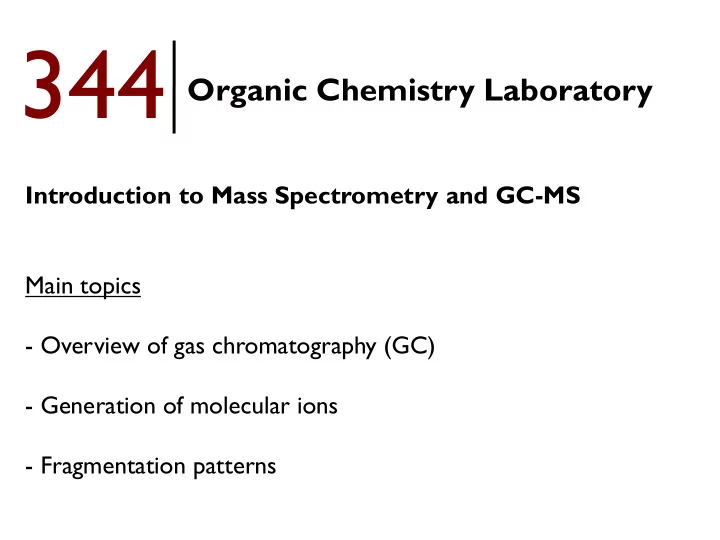

344 Organic Chemistry Laboratory Introduction to Mass Spectrometry and GC-MS Main topics - Overview of gas chromatography (GC) - Generation of molecular ions - Fragmentation patterns
Chromatography – separation of a mixture into individual components Gas Chromatography (GC) coupled to EI-MS Organic sample needs to be sufficiently volatile to vaporize Stationary phase = packed column Mobile phase = He
GC trace – mixture of aromatic hydrocarbons (BTEX) 2.4 min 0.7 min 1.2 min 2.3 min 2.7 min Detector output ( m V) Retention Time (min) GC-MS - a mass spectrum is obtained for each compound as it elutes from the GC www.npl.co.uk
Electron Impact-Mass Spectrometry (EI-MS) Uses high energy electron beam (70 eV), sample in gas phase Ionization energy for most organic molecules ~8-15 eV Molecule Molecular Ion [M] .+ gives the molecular mass in amu (m) of M bond breaking bond forming Molecular Fragments Information on connectivity of the molecule, isotopes
EI-Mass Spectrum of Methanol CH 3 OH 31 32
Generation of [M] . + From where on the molecule is the electron most likely to be removed? Alkanes – s bond Alkenes – p bond Heteroatom compounds (O, N, S, etc.) – non-bonding lone pairs
Generation of fragments from [M] . + ✗ ✔ Cation Radical [B-C] [A] + [A-B-C] Molecular Ion [B-C] [A] ✔ Radical cation + ✗ ✔ Radical Cation
Generation of fragments from [M] . + [ C ] + [A-B-C] [ A - B ] ✗ ✔ Neutral Radical cation Molecular Ion ✔ Radical cation Only CATIONS and RADICAL CATIONS are detected by EI-MS. Radicals and other neutral molecules (CO, H 2 O, alkenes) NOT detected by EI-MS.
EI-Mass Spectrum of Octane C 8 H 18 43 57 29 85 71 114
Octane MW = 114 g/mol Both fragmentations involve formation of a Me radical or a Me cation 3 o > 2 o > 1 o > Me
Octane MW = 114 g/mol ✔ ✔ Stability of cation and radical is important
Octane MW = 114 g/mol ✔ ✔
Octane MW = 114 g/mol ✔ Stability of cation and radical is important. Fragmentations involving formation of a Me species are disfavored.
EI-Mass Spectrum of Octane C 8 H 18 43 Base peak MW = 114 g/mol 57 29 85 71 114 15
EI-Mass Spectrum of 2-methylpentane 43 MW = 86 g/mol 71 29 86
m/z = 43 forms readily and is persistent in the chamber. m/z = 71 may form readily, but fragments more rapidly. 2-Methylpentane MW = 86 g/mol m/z = 86 mass = 15 m/z = 71 m/z = 86 mass = 43 m/z = 43 Branched alkanes fragment either side of the branch point(s).
EI-Mass Spectrum of 2-methylpentane 43 MW = 86 g/mol 71 29 86
Isotope patterns Atoms exist as isotopes (different # neutrons, same # protons) 12 C is most abundant isotope of carbon ~1.08 % of C-atoms in any sample are 13 C isotope (NMR active, useful) ~0.016% of H-atoms in any sample are 2 H isotope (D) ~0.38% of N-atoms in any sample are 15 N isotope Atomic mass Br = 79.90 amu 79 Br 50.7 % 81 Br 49.3 % ~1:1 ratio of 79 Br: 81 Br isotopes Atomic mass Cl = 35.48 amu 35 Cl 75.8 % 37 Cl 24.2 % ~3:1 ratio of 35 Cl: 37 Cl isotopes
EI-Mass Spectrum of 1-Bromobutane 57 Br = 79.90 g/mol 79 Br 50.7 % 81 Br 49.3 % MW = 137 g/mol 29
EI-Mass Spectrum of Benzyl chloride Cl = 35.48 g/mol 35 Cl 75.8 % 37 Cl 24.2 % MW = 126.5 g/mol
EI-Mass Spectrum of Methanol CH 3 OH 31 32 29 15 30 28
EI-Mass Spectrum of 2-octanone 58 43 MW = 128 g/mol 71 128 29 113 15
EI-Mass Spectrum of 2-octanone 58 43 MW = 128 g/mol 71 128 29 113 15
Recommend
More recommend